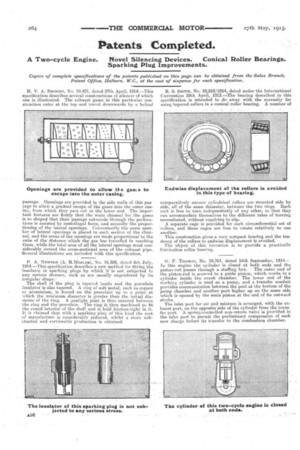Patents Completed.
Page 20

If you've noticed an error in this article please click here to report it so we can fix it.
A Two-cycle Engine. Novel Silencing Devices. Conical Roller Bearings. Sparking Plug Improvements.
Copies of complete specifications of the patents published on this page can be obtained from the Sales Branch, Patent Office, Holborn, WC., at the cost of sixpence for each specification.
H. V. A. BRIsckm, No. 10,421, dated 27th April, 1914.—This specification describes several constructions of silences' of which one is illustrated. The exhaust gases in this particular construction enter at the top and travel downwards by a helical
passage. Openings are provided in the side walls of this pas sage to allow a gradual escape of the gases into the outer casing, from which they pace out at the lower end. The important features are firstly that the main channel for the gases is so shaped that their passage outwards through the perforations is assisted by centrifugal force, and secondly the proportioning of the lateral openings. Conveniently the same number of lateral openings is placed in each section of the channel, and the areas of the openings are Made proportional to the cube of the distance Which the gas has travelled in reaching them, while the total area of all the lateral openings must considerably exceed the cross-sectional area of the exhaust pipe. ScrveraI illustrations are inclnded with this specification.
P. A. NEWTON (A. R.Illoss.nri), No. 16,308, dated 8th July, 1914.—ThiS specification describes a new method for fitting the 'insulator in sparking 'pings by which it is not subjected to any serious itressus, such as are usually engendered by its irregular' shape.
The shell of the plug is tapered inside and the porcelain insulator is also tapered. A ring of soft metal, such as copper or aluminium, is forced on the porcelain' up to a point at which the minimum diameter is greater than the initial diameter of the ring.. A gastight joint is thus ensured between the ring and the porcelain. Thering is then machined to fit the coned interior of the shell and is held friction-tight in it; Ills claimed that with a sparking plug of this kind the cost of manufacture is considerably reduced, whilst a more subrtantial and serviceable production is obtained. R. S. Smrrn, Nn. 10,218/1914, dated under the International Convention 28th April, 1913.—The bearing described in this specification is intended to do away with the necessity for using tapered rollers in a conical roller bearing. A number of comparatively narrow cylindrical rollers are mounted side by side, all of the same diameter, between the two rings. Each unit is free to turn independently of any other, so that they can accommodate themselves to the different rates of turning necessitated, without requiring to slip.
A separate cage is provided for each circumferential set of rollers, and these cages are free to rotate relatively to one another.
This construction gives a very compact bearing and the tendency of the rollers to endwise displacement is avoided.
The -object of this invention is to provide a practically frictionless roller bearing.
G. F. THOMAS, No. 19,761, dated 14th September, 1914.In this engine the cylinder is closed at both ends and the piston-rod passes through a stuffing box. • The Mater end of the piston-rod is secured to a guide piston, which works in a cylinder inside the crank chamber. The lower end of the working cylinder is used as a pump, and a transfer conduit provides communication between the port at the bottom of the pump chamber and another port higher up on the same side which is opened by the main piston at the end of its outward stroke.
The inlet port for air and mixture is arranged, with the exhaust port, on the opposite side of the cylinder from the transfer port. A spring-controlled non-return valve is provided in the inlet port to permit the preliminary compression of each new charge before its transfer to thecombustion chamber.




















